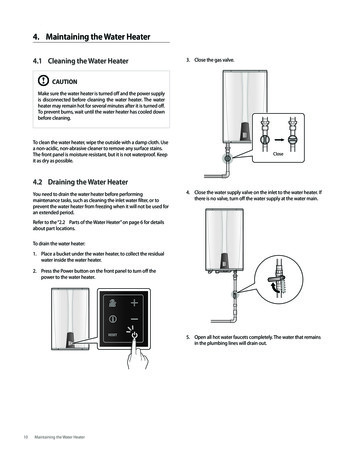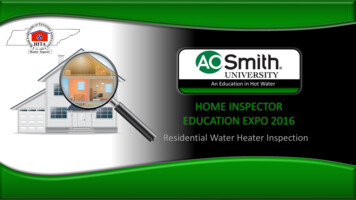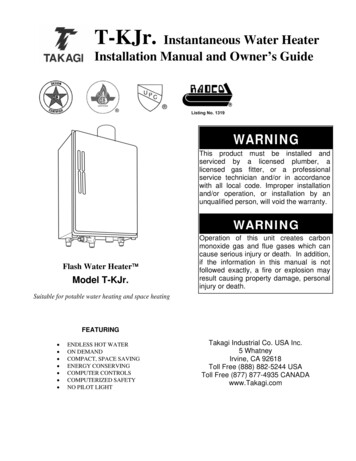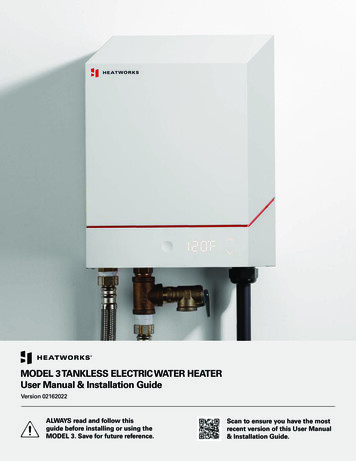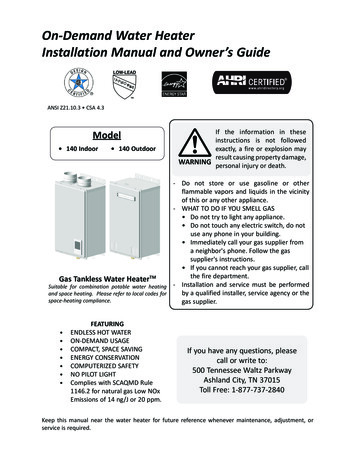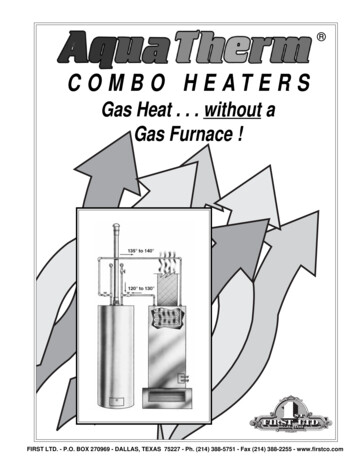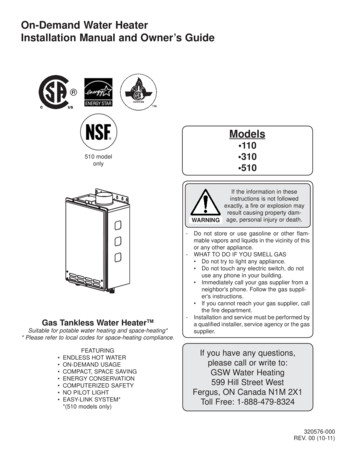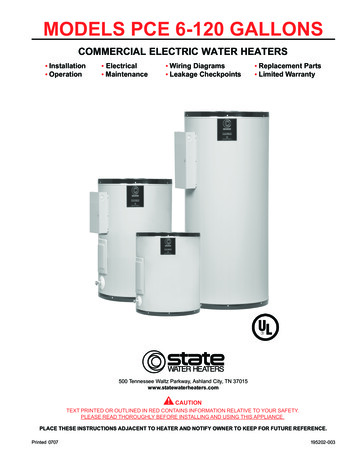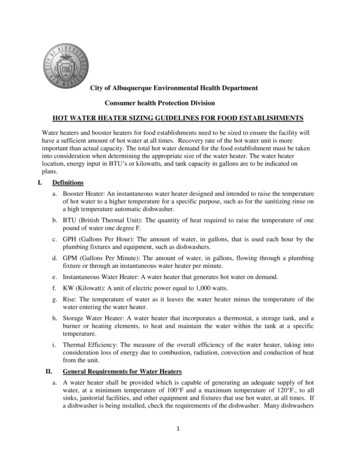
Transcription
City of Albuquerque Environmental Health DepartmentConsumer health Protection DivisionHOT WATER HEATER SIZING GUIDELINES FOR FOOD ESTABLISHMENTSWater heaters and booster heaters for food establishments need to be sized to ensure the facility willhave a sufficient amount of hot water at all times. Recovery rate of the hot water unit is moreimportant than actual capacity. The total hot water demand for the food establishment must be takeninto consideration when determining the appropriate size of the water heater. The water heaterlocation, energy input in BTU’s or kilowatts, and tank capacity in gallons are to be indicated onplans.I.Definitionsa. Booster Heater: An instantaneous water heater designed and intended to raise the temperatureof hot water to a higher temperature for a specific purpose, such as for the sanitizing rinse ona high temperature automatic dishwasher.b. BTU (British Thermal Unit): The quantity of heat required to raise the temperature of onepound of water one degree F.c. GPH (Gallons Per Hour): The amount of water, in gallons, that is used each hour by theplumbing fixtures and equipment, such as dishwashers.d. GPM (Gallons Per Minute): The amount of water, in gallons, flowing through a plumbingfixture or through an instantaneous water heater per minute.e. Instantaneous Water Heater: A water heater that generates hot water on demand.f. KW (Kilowatt): A unit of electric power equal to 1,000 watts.g. Rise: The temperature of water as it leaves the water heater minus the temperature of thewater entering the water heater.h. Storage Water Heater: A water heater that incorporates a thermostat, a storage tank, and aburner or heating elements, to heat and maintain the water within the tank at a specifictemperature.i.II.Thermal Efficiency: The measure of the overall efficiency of the water heater, taking intoconsideration loss of energy due to combustion, radiation, convection and conduction of heatfrom the unit.General Requirements for Water Heatersa. A water heater shall be provided which is capable of generating an adequate supply of hotwater, at a minimum temperature of 100 F and a maximum temperature of 120 F., to allsinks, janitorial facilities, and other equipment and fixtures that use hot water, at all times. Ifa dishwasher is being installed, check the requirements of the dishwasher. Many dishwashers1
require an incoming water temperature that is hotter than 120 F. Follow the recommendedtemperature requirements of the dishwasher manufacturer.b. Water heaters and their installation must be in compliance with all local building coderequirements.c. Water heaters that use reclaimed heat from equipment to heat water must be evaluated on acase-by-case basis.III.Sizing Requirements for Storage Water Heatersa. For food facilities that utilize multiservice eating and drinking utensils, the water heater shallhave a recovery rate equal to or greater than 100% of the computed hourly hot water demand,in gallons per hour (GPH).b. For food facilities that use only single-service eating and drinking utensils, or don't useutensils at all, the water heater shall have a recovery rate equal to or greater than 80% of thecomputed hourly hot water demand, in GPH.c. For food facilities that handle and sell only prepackaged foods, a water heater with aminimum storage capacity of ten gallons is normally sufficient. Prepackaged food facilitiesthat have more than a janitorial sink and two handsinks should use the sizing criteria outlinedin this chapter.d. The hourly hot water demand for the food facility, in GPH, is calculated by adding togetherthe estimated hot water demands for all sinks and other equipment, such as dishwashers,which utilize hot water. The hot water demands for automatic warewashers, such asdishwashers, glasswashers, and potwashers are found in NSF International listings or listingsestablished by other nationally recognized testing laboratories.e. The following are estimated hot water demands for sinks and other equipment that utilize hotwater:IV.Fixture Hourly demandUtensil sinks 18” x 18” 14 gallons per compartment 24” x 24” 25 gallons per compartment Custom sink sizes can be calculated using the formula: Length x Width x Average Depth x 7.5 gallons per compartmentBar sinks 6 gallons per compartmentFood preparation sinks 5 gallons per sinkJanitorial sinks 15 gallons per sinkGarbage can wash facility 15 gallons per facilityHand sinks 5 gallons per sinkPre-rinse units Hand spray type 45 gallons Other types of unit refer to manufacturer’s specifications2
Clothes washers 9 and 12 pound washers 45 gallons 16 pound washers 60 gallonsEmployee shower 20 gallons per showerFor other fixtures that utilize hot water; see manufacturer’s specifications.V.Calculations for Hourly Hot Water DemandThe following examples are provided to explain how to calculate the total hourly hot waterdemand:a. Food facility that utilizes only single service eating and drinking utensils:Assume:1 18" x 18" three compartment sink 42 GPH2 hand lavatories 10 GPH (5 GPH ea.)1 janitorial sink 15 GPH(42 10 15) 67 GPH total hourly hot water demand67 GPH x 80% allowance for single service utensils 54 GPHFor the food facility in this example, a water heater would be required which will recover 54GPH.b. Food facility that utilizes multiservice eating and drinking utensils:Assume:1 18" x 18" three-compartment sink 42 GPHAutomatic dishmachine 80 GPHHand spray pre-rinse 45 GPHOne compartment food preparation sink 5 GPH2 hand lavatories 10 GPH (5 GPH ea.)1 janitorial sink 15 GPH(42 80 45 5 10 15) 197 GPH total hourly hot water demandSince the food facility in this example uses multiservice eating and drinking utensils, 100%of the computed hourly hot water demand must be provided. Therefore, a water heater wouldbe required which will recover 197 GPH.c. To compute a BTU or KW rating for the required hourly hot water demand found in examplea, the following formulas should be used:Formula 1 (for gas water heaters)BTU input GPH x Rise x 8.33 lb./ gallon of waterThermal EfficiencyBTU input 54 GPH x 60 F X 8.33 lb.3
.75BTU input 35,985Formula 2 (for electric water heaters)KW input GPH x Rise X 8.33 lb./ gallon of waterThermal Efficiency x 3412 BTU/KWKW input 54 GPH x 60 F x 8.33 lb.98 x 3412 BTU/KWKW input 8VI.Sizing Requirements for Instantaneous Water Heatersa. One of the advantages of an instantaneous water heater is its ability to provide a continuoussupply of hot water. However, since the water passes through a heat exchanger, the watermust flow through the unit slowly to ensure proper heat transfer. Therefore, the quantity, orrate, at which the hot water is delivered, can be significantly less than that provided by astorage water heater. When hot water is utilized at several locations of the food facility at thesame time the flow of hot water to each fixture can be severely restricted. As a result of therestricted output of instantaneous water heaters, more than one unit may be required,depending on the numbers and types of sinks and equipment present. Instantaneous waterheaters must be sized to provide hot water of at least 120 F., and at a rate of at least twogallons per minute (GPM) to each faucet. Most existing gas lines will not carry the gas loadnecessary for an instantaneous water heater. Either larger gas lines will need to be installed tocarry the extra load, or the gas pressure will need to be increased at the meter. This is an extraexpense that is often discovered after installation. (Note: Hand lavatories and foodpreparation sinks must receive at least ½ GPM.) The following example is provided toexplain how this sizing criteria is applied:Assume:1 18" X 18" three-compartment sink 2 GPM2 hand lavatories 1 GPM (½ GPM each)1 janitorial sink 2 GPM(2 1 2) 5 GPMIn the example given above, one or more instantaneous water heaters would have to beprovided in order to supply a total of at least 5 GPM.b. Food facilities that install an automatic warewashing machine that utilizes a large quantity ofhot water may be required to provide an instantaneous water heater exclusively for thewarewashing machine. NSF International listings or listings established by other nationallyrecognized testing laboratories are used to determine the minimum GPM hot water demandfor automatic warewashing machines.VII.Requirements for Booster Heatersa. When a hot water sanitizing warewashing machine is used, a booster heater must be providedthat will raise the incoming general purpose hot water up to at least 180 F. for the finalsanitizing rinse cycle.4
b. When sizing a booster heater, the hot water demand for the warewashing final sanitizingrinse cycle should be obtained from the NSF International listings or listings established byother nationally recognized testing laboratories.c. The formulas for calculating BTU or KW input should be used when determining theminimum required size for a booster heater.d. When a booster heater is installed below a drainboard, it shall be installed at least six inchesabove the floor and away from the wall, and in a manner that will allow accessibility forproper cleaning and servicing.e. If a booster heater is installed or if the water temperature needs to be set above 120 F to meetthe demands of fixtures such as a high temperature dishwasher, the water must be temperedat the other fixtures to prevent scalding.VIII.Recirculation Pumpsa. Where fixtures are located more than fifty feet from the water heater, a recirculation pumpmust be installed, in order to ensure that water reaches the fixture at a temperature of at least120 F.b. In some cases it may be more practical to install a separate, smaller water heater for remotefixtures, such as for restroom handsinks, in order to ensure that hot water reaches thehandsink within fifteen seconds.IX.Installation Requirementsa. Where feasible, water heaters should be located in an area of the food facility separated fromall food and utensil handling areas.b. The Uniform Building Code prohibits the installation of gas water heaters in restrooms orchange rooms.c. Water heaters shall be mounted in one of the following manners:1. On six inch high, easily cleanable legs.2. On a four inch high coved curb base. All openings between the water heater and thebase must be sealed in a watertight manner.3. On a properly finished and installed wall pedestal, positioned so that it is out of thework and traffic space.4. In an easily accessible location above a suspended ceiling. Where a permanentlyinstalled ladder is required to access the water heater, the ladder shall not be installedabove a food or utensil handling area.5. Note: The local health agency may allow alternate installation methods when a waterheater is installed in an area separated from food and utensil handling areas, such asin a mechanical room.d. A common mistake with electric water heaters is the ordering and installing of a water heaterwith an upper element of 4500 watts, a bottom element of 4500 watts, and a total connected(or maximum) wattage of 4500 watts. On such a water heater only one element is operatingat any one time. Many individuals do not observe the total connected wattage and incorrectlyassume that because each of the elements is 4500 watts their water heater has an input ratingof 9000 watts.5
Water heater manufacturers have specific procedures for rewiring an electric water heater sothat the upper and lower elements are operating simultaneously. Some manufacturers onlypermit rewiring in the factory. Field modifications will normally void warranties and anylistings that the unit comes with. Prior to acceptance of a field modified water heater, thelocal health agency should ensure that the modifications were performed according to themanufacturer's recommendations and with the approval of the local building officials. Thedata plate on a field modified water heater must be changed to reflect the total connectedwattage rating with both elements operating simultaneously.e. When multiple water heaters are connected, they must be installed in parallel, not in series.Refer to the illustration at the end of this document to see an example of this type ofinstallation.X.Sizing Table for Gas Hot Water HeatersGallons Per Hour Delivery At Indicated Temperature RiseBTU (X 1000)40 F50 F60 F70 871931992066
77283289296302309315322Sizing Table for Electric Hot Water HeatersGallons Per Hour Delivery At Indicated Temperature RiseKW40 F50 F60 F70 1321381431491557
47252258264270275281287
XII.Water Heaters Installed In Parallel9
e. Instantaneous Water Heater: A water heater that generates hot water on demand. f. KW (Kilowatt): A unit of electric power equal to 1,000 watts. g. Rise: The temperature of water as it leaves the water heater minus the temperature of the water entering the water heater. h.
